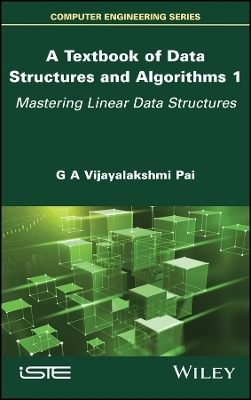
A Textbook of Data Structures and Algorithms, Volume 1
ISTE Ltd and John Wiley & Sons Inc (Verlag)
978-1-78630-869-6 (ISBN)
A Textbook of Data Structures and Algorithms is a textbook that can be used as course material in classrooms, or as self-learning material. The book targets novice learners aspiring to acquire advanced knowledge of the topic. Therefore, the content of the book has been pragmatically structured across three volumes and kept comprehensive enough to help them in their progression from novice to expert.
With this in mind, the book details concepts, techniques and applications pertaining to data structures and algorithms, independent of any programming language. It includes 181 illustrative problems and 276 review questions to reinforce a theoretical understanding and presents a suggestive list of 108 programming assignments to aid in the implementation of the methods covered.
G A Vijayalakshmi Pai, SMIEEE is a Professor of Computer Applications at PSG College of Technology, Coimbatore, India. She has authored books and investigated research projects funded by government agencies in the disciplines of Computational Finance and Computational Intelligence.
Preface ix
Acknowledgments xv
Chapter 1. Introduction 1
1.1. History of algorithms 3
1.2. Definition, structure and properties of algorithms 4
1.2.1. Definition 4
1.2.2. Structure and properties 4
1.3. Development of an algorithm 5
1.4. Data structures and algorithms 6
1.5. Data structures -- definition and classification 7
1.5.1. Abstract data types 7
1.5.2. Classification 9
1.6. Algorithm design techniques 9
1.7. Organization of the book 11
Chapter 2. Analysis of Algorithms 13
2.1. Efficiency of algorithms 13
2.2. Apriori analysis 15
2.3. Asymptotic notations 17
2.4. Time complexity of an algorithm using the O notation 19
2.5. Polynomial time versus exponential time algorithms 20
2.6. Average, best and worst case complexities 21
2.7. Analyzing recursive programs 23
2.7.1. Recursive procedures 23
2.7.2. Apriori analysis of recursive functions 27
2.8. Illustrative problems 31
Chapter 3. Arrays 45
3.1. Introduction 45
3.2. Array operations 46
3.3. Number of elements in an array 46
3.3.1. One-dimensional array 46
3.3.2. Two-dimensional array 47
3.3.3. Multidimensional array 47
3.4. Representation of arrays in memory 48
3.4.1. One-dimensional array 49
3.4.2. Two-dimensional arrays 51
3.4.3. Three-dimensional arrays 52
3.4.4. N-dimensional array 53
3.5. Applications 54
3.5.1. Sparse matrix 54
3.5.2. Ordered lists 55
3.5.3. Strings 56
3.5.4. Bit array 58
3.6. Illustrative problems 60
Chapter 4. Stacks 71
4.1. Introduction 71
4.2. Stack operations 72
4.2.1. Stack implementation 73
4.2.2. Implementation of push and pop operations 74
4.3. Applications 76
4.3.1. Recursive programming 76
4.3.2. Evaluation of expressions 79
4.4. Illustrative problems 83
Chapter 5. Queues 101
5.1. Introduction 101
5.2. Operations on queues 102
5.2.1. Queue implementation 102
5.2.2. Implementation of insert and delete operations on a queue 103
5.2.3. Limitations of linear queues 105
5.3. Circular queues 106
5.3.1. Operations on a circular queue 106
5.3.2. Implementation of insertion and deletion operations in circular queue 109
5.4. Other types of queues 112
5.4.1. Priority queues 112
5.4.2. Deques 117
5.5. Applications 119
5.5.1. Application of a linear queue 119
5.5.2. Application of priority queues 120
5.6. Illustrative problems 125
Chapter 6. Linked Lists 143
6.1. Introduction 143
6.1.1. Drawbacks of sequential data structures 143
6.1.2. Merits of linked data structures 145
6.1.3. Linked lists -- structure and implementation 145
6.2. Singly linked lists 147
6.2.1. Representation of a singly linked list 147
6.2.2. Insertion and deletion in a singly linked list 149
6.3. Circularly linked lists 155
6.3.1. Representation 155
6.3.2. Advantages of circularly linked lists over singly linked lists 155
6.3.3. Disadvantages of circularly linked lists 156
6.3.4. Primitive operations on circularly linked lists 158
6.3.5. Other operations on circularly linked lists 159
6.4. Doubly linked lists 160
6.4.1. Representation of a doubly linked list 161
6.4.2. Advantages and disadvantages of a doubly linked list 162
6.4.3. Operations on doubly linked lists 163
6.5. Multiply linked lists 166
6.6. Unrolled linked lists 171
6.6.1. Retrieval of an element 172
6.6.2. Insert an element 172
6.6.3. Delete an element 173
6.7. Self-organizing lists 175
6.8. Applications 175
6.8.1. Addition of polynomials 176
6.8.2. Sparse matrix representation 178
6.9. Illustrative problems 182
Chapter 7. Linked Stacks and Linked Queues 201
7.1. Introduction 201
7.1.1. Linked stack 202
7.1.2. Linked queues 203
7.2. Operations on linked stacks and linked queues 203
7.2.1. Linked stack operations 203
7.2.2. Linked queue operations 204
7.2.3. Algorithms for Push/Pop operations on a linked stack 205
7.2.4. Algorithms for insert and delete operations in a linked queue 206
7.3. Dynamic memory management and linked stacks 209
7.4. Implementation of linked representations 214
7.5. Applications 216
7.5.1. Balancing symbols 216
7.5.2. Polynomial representation 218
7.6. Illustrative problems 222
References 241
Index 243
Summaries of other volumes 245
| Erscheinungsdatum | 27.01.2023 |
|---|---|
| Verlagsort | London |
| Sprache | englisch |
| Gewicht | 1002 g |
| Themenwelt | Informatik ► Theorie / Studium ► Algorithmen |
| Technik ► Elektrotechnik / Energietechnik | |
| ISBN-10 | 1-78630-869-X / 178630869X |
| ISBN-13 | 978-1-78630-869-6 / 9781786308696 |
| Zustand | Neuware |
| Haben Sie eine Frage zum Produkt? |
aus dem Bereich


